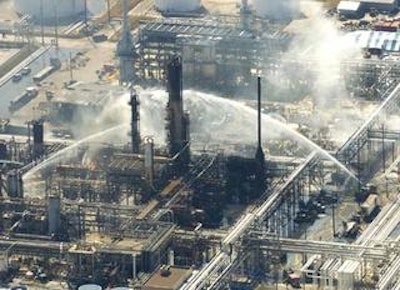
 As the federal agency charged with investigating industrial chemical accidents, the U.S. Chemical Safety Board (CSB) has a bird’s-eye view on safety trends impacting the industry.
As the federal agency charged with investigating industrial chemical accidents, the U.S. Chemical Safety Board (CSB) has a bird’s-eye view on safety trends impacting the industry.
In a recent interview with Chem.info, the CSB’s Chairman, Rafael Moure-Eraso, pinpointed three areas where he sees chemical facilities concentrating their efforts.
“[In the coming year] we expect that chemical companies are going to look at safety a lot more seriously,” he said.
Reinvestment
“This industry is so profitable that … [companies] will be putting their profits back into the plants for safety measures,” said Moure-Eraso.
Thanks to a rebounding economy and cheaper feedstock costs, Moure-Eraso said it’s the perfect time to pump new funds into safety efforts, such as preparing the workforce for accidents and improving equipment.
“We expect [chemical companies] will be looking at training,” he said. “We would like to see [them also] looking at safer designs.”
Safety investments could save companies big in the long run.
“As in the case of Chevron [a 2012 refinery fire that endangered 19 workers and sent 15,000 people to the hospital], the piping they were using was liable to corrode very fast. So they gave it a few more years before replacing it … they took the risk and they lost.”
Technology
“We are finding the need for safer designs,” said Moure-Eraso. “There are safer technologies that we would like to see more of in the chemical industry.
The Chevron Refinery fire is another good case-in-point.
“There are piping materials that are resistant to corrosion, for example,” Moure-Eraso said.
But Moure-Eraso noted that management needs to be willing to make the hunt for safer designs a priority.
“Chemical operations management need to take advantage of [technologies],” he said. “We would like companies to [decide] to have safety aimed at the prevention of risks. Our findings indicate that in order to prevent catastrophic events this has to catch or we’re going to have more accidents.”
Regulations
Every year the CSB investigates the biggest chemical accidents in the U.S., searching for root causes. In some cases lack of up-to-date regulations have been a contributing factor.
“We have the charter to tell the regulators when we believe that the regulations failed to prevent a particular accident,” Moure-Eraso said. “So we have identified some regulations as obsolete.”
Moure-Eraso is hoping for a fundamental shift in the U.S.’s approach to regulatory safety measures.
“The current regulations are big on making analysis but there is very little on what we should do to decrease the risk,” he explained. “In our investigations we are finding [companies] were compliant with analysis but there were no plans for decreasing risk with specific actions.”
“[Rules] haven’t been changed since 1982 so we’re talking about more than 20 years where regulations have been static,” Moure-Eraso explained.
In August of 2013, President Obama issued an executive order aimed at improving chemical facility safety and security, which started a process to finally update the rules. Since then, industry stakeholders and several federal agencies, including the CSB, OSHA and the EPA, have been involved in the complicated process of updating regulations. Moure-Eraso submitted written testimony to the Senate committee charged with overseeing the process, while other agencies put together comprehensive reports on needed change.
The recommendations have zeroed in on modernizing regulations, promoting safer technology and improving agency information sharing.
The EPA gave stakeholders until October 2014 to provide comments on regulatory changes. It is now expected rulemaking will begin this summer, and that new regulations will start going into effect in 2016.























